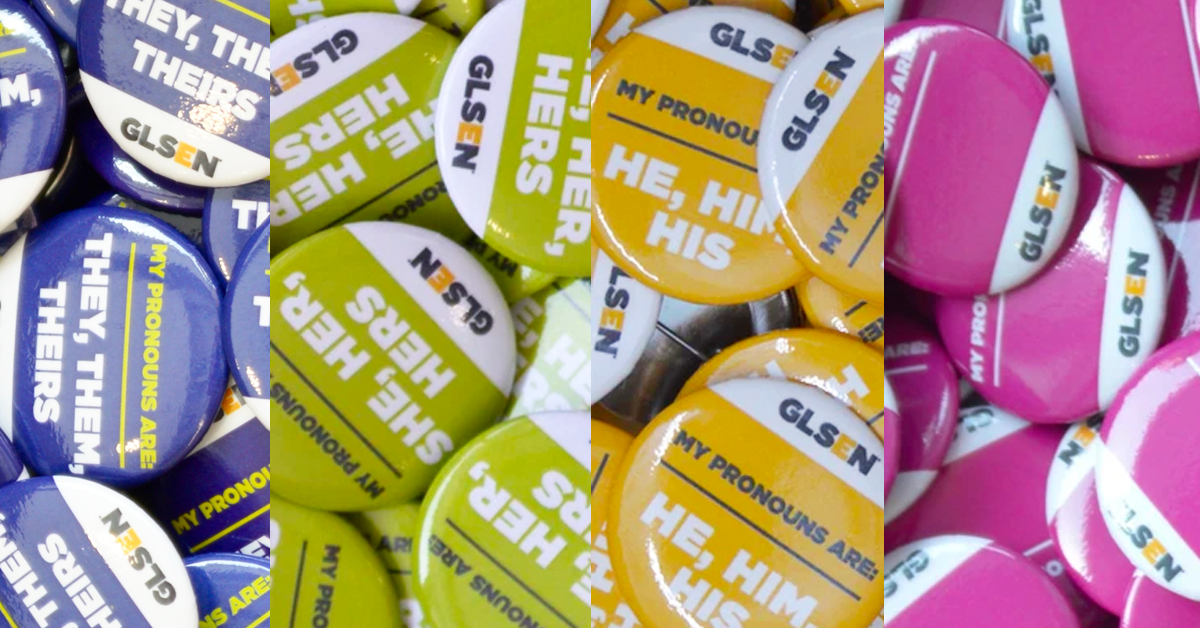
Pronoun Guide

Purchase Pronoun Buttons
Purpose of this Guide
This guide is created to help anyone learn how to use people’s correct pronouns. Everyone in your school community should engage in learning, educating, and advocating for the inclusive use of pronouns for all.
What Are Pronouns?
Pronouns are the words you may like others to use for you in place of your proper name. Some examples include “she/her” or “he/him” or gender-neutral pronouns, such as “ze/hir,” [pronounced: zee/heer] or “they/them”. Some people use specific pronouns, any pronouns, or none at all. Here is an example of using “they/them” in a sentence: John is substituting for me today and they are an incredible mathematician.
Using singular “they” pronouns have been used in the English language for centuries. If you are still struggling with using this, remember, it takes practice!
Why Focus on Pronouns?
You may have noticed that people are sharing their pronouns in introductions, on name tags, and at the beginning of meetings. This gives everyone in the room the opportunity to self identify instead of assuming someone’s identity or which pronouns they use. Including pronouns is a first step toward respecting people’s identity and creating a more welcoming space for people of all genders.
How Is This More Inclusive?
Pronouns can sometimes be a signifier for someone’s gender identity but not always. We do not want to assume people’s gender identity based on expression (typically shown through clothing, hairstyle, mannerisms etc.) By providing an opportunity for people to share their pronouns, you’re showing that you’re not assuming that their gender identity is based on their appearance.
What If I Don’t Want to Share My Pronouns?
That’s ok! Providing space and opportunity for people to share their pronouns does not mean that everyone feels comfortable or needs to share their pronouns. Some people may choose not to share their pronouns for a variety of reasons, e.g. they are questioning or using different pronouns, they don’t use any pronouns, they don’t feel comfortable sharing them at that moment or in that space, or they fear bullying or harassment after sharing. *In the case that someone has left pronouns off the nametag or chosen not to share their pronouns, please refrain from using pronouns for that person and refer to the person by what is on the nametag.
Mistakes and Misgendering
Misgendering refers to the experience of being labeled by others as a gender other than one that a person identifies with. Because many (not all) associate their pronouns with their gender identity, using the wrong pronouns intentionally or unintentionally is a form of misgendering. If you accidentally use the wrong pronoun when identifying someone, please apologize or say “thank you”, and immediately use the right pronoun.
i.e. This is Alex, she is one of my science students. (you are corrected because Alex uses they/them/theirs pronouns). Sorry, they are one of my science students. Or Thank you, they are one of my science students.
Everyone makes mistakes, please take accountability for your mistake and continue using the correct pronoun. The important thing to be mindful of, is to not unload your guilty feelings on transgender, nonbinary, and gender nonconforming people or expect forgiveness. They might have a strong reaction to the misuse of their pronouns and need space to recenter themselves.
What About PGP?
There has been a shift away from the term “preferred gender pronoun” or “PGP” to just using “pronoun.” This change was made because a person’s pronouns are not just preferred; they’re the pronouns that must be used. In the same sense as mentioned earlier, gender was removed because pronouns do not always reflect or indicate someone’s gender.
Make Your Support Visible!
Include “pronoun:” under “name:” in name tags and introductions in groups as an opportunity for participants to make their pronouns visible. At the beginning of the semester, educators can call out students by their last name instead of their first name in case a student has not been able to change their name in the Student Information System or legally. Let students know that after class they can let you know what name they use if it is different than what is on the roster.
At the beginning of the semester, educators can pass out 3x5 notecards to students and ask them to add their name, pronouns, and whatever information you feel is necessary to know about the student that they might not want to share out loud.
Have pronouns be added to all email signatures, and link the word “pronouns” to this guide or another reference for people who are new to this practice:
Sincerely,
Mx. Marvel
Pronouns: They, Them, Theirs
Tips for Gender-Neutral Language:
- Practice, practice, practice! Use gender-neutral pronouns such as “they” and “ze” while visualizing the person who uses them. This is especially useful to do right before you’re about to see the person.
- When addressing groups of people or people whose pronouns you haven’t been told, use gender-neutral language such as, “siblings,” “third graders,” “students”, “friends,” “folks,” “all,” or “y’all,” rather than “brothers and sisters,” or “guys,” “ladies,” “ma’am,” or “sir.”
- Use descriptive language if you do not know a person’s gender, pronouns, or name. e.g. Can you give this paper to the person across the room with the white t-shirt and short brown hair?
Share this resource with others and open conversations and support to make sure you are engaging in respecting people’s identities and pronouns. Growing and learning takes time! Educate, engage, emend!
Other resources from GLSEN for supporting Trans/GNC Youth
-
Video on genderfluidity by one of GLSEN's National Student Council members
-
Blogs on nonbinary identity and transgender binary-privilege
- Make your GSA more Trans and GNC Inclusive
Leading Organizations for Transgender Advocacy:
- Trans Women of Color Collective
